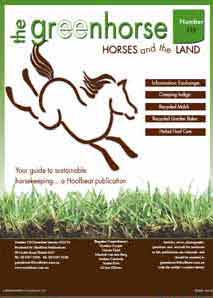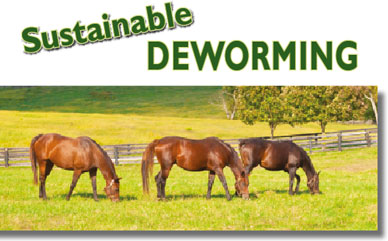The Green Horse section provides practical information on managing environmentally sustainable horse properties, readers stories and tips, as well as advice and articles from equestrian experts in their fields.
February March '22
Vol 43 No 5
In this issue of The Green Horse you will find the following articles
ANTS
by Rhiannon Brown - EnvirapestControlling ants is always a challenge, due to their sheer number and colony structures. To really get long lasting control you need to use products that target the queen.
SUSTAINABLE DEWORMING
by Sophie Fletcher
There has been a relatively big shift in deworming treatment strategies in recent years, due to increasing levels of worm resistance to the chemicals we have been using for decades to control them, resulting in a lot of confusion among horse owners.
WORKING THRU SUMMER
by Country Park Herbs
You can enjoy riding your horse during these
hot and humid months if you keep it well hydrated and avoid overexertion.
TWITCHING - ‘horse safe’ wooden post and rail fence twitch.
by Liz Tollarzo
Fencing is a major factor on any horse property and even the small items like a twitch- to hold the rails and posts together -can become a source of injury, if not done correctly.
WIN A YEAR'S SUBSCRIPTION...
share your equine property management tips and each issue one reader will win.
Send ideas to -
The Green Horse Support <enquiries@hoofbeats.com.au>


PREVIOUS ARTICLES
Available on line
December/January 21/22
ARE YOU PREPARED FOR THE FIRE SEASON
In the many areas where horse owners live this season's fire preparation should be well underway; if you’ve not already started preparing your property for summer then now is the time to do so.
October/November21
SNAKE UNIVERSAL ANTIVENOM
The good news is that there is no longer any need for a snake to be identified to administer antivenom. A universal antivenom is now used that covers the five genus of snake that will cause serious harm or death.
August/September 21
BEAT THE BINDI
by Rhiannon Brown - Envirapest
The prickly weeds that grow on our properties across Australia usually have long classical Latin names, are often known by a variety of common names in different localities but are regularly called very rude names when we happen to stand on one (or a dozen) or when they find our hands as we are dislodging tangles in the horse’s mane or tail.
June July 21
BARN OWLS by Wendy Elks
A silent partner in rodent control.
Non-toxic pest management is the most humane and ecologically sustainable way of bringing nature back into some kind of balance during non-plague times.
April/May 21
LOVELY LAWNS
by Rhiannon Brown - Envirapest
On a horse property there always seems to be hectares of grass, but we all have that little bit of lawn we want to look luscious all year round.
It could be the entrance to the stables, laneways bordering the driveway, that little ‘special’ snack paddock or you could even dream of a beautiful green arena. So, how do we achieve this?
Feb/March 21
STABLE DANGERS
by Elizabeth Tollarzo
They say that horses are accidents-waiting-to-happen as they are inclined to find every conceivable way to injur themselves, usually just before a competition. Being aware of potential dangers in the stable - and addressing these - may help aleiviate injury.
Dec/Jan 20/21
HORSES AND HONEY BEES-
Can they share space on the property?
by Wendy Elks
Oct/Nov 20
SOLAR-POWERED PRODUCTS
by Celine Bønnelykke
In previous issues we have discussed the economics of setting up a solar-driven property, but if finances don’t stretch to installation of the whole package, there are ways to ease into the solar-world.
Aug/Sept 20 THE HIDDEN DANGERS IN OUR PADDOCK.
by Elizabeth Tollarzo
Horses love to run, play, buck and then run again and we often, through lack of risk assessment or management practices, place them in areas that are fraught with dangers.
JUNE JULY 20 GOING SOLAR ON THE HORSE PROPERTY Where to put your panels Part 2
Once you have selected what solar system best suits your needs, then you need to look at how you can maximise the advantages.
APRIL MAY 20 GOING SOLAR ON THE HORSE PROPERTY Part 2
Once you have selected what solar system best suits your needs, then you need to look at how you can maximise the advantages.
FEB/MARCH 20 ANTS AWAY
by Mark Brown Envirapest
So, what can you do to deter ants from your house and your stables??
DJ19/20 KEEPING SNAKES OUT OF THE STABLE by Wendy Elks
Snakes may be protected under Wildlife regulations in Australia, and they may be great for keeping the mice and rats down, but do we want to find them in our stables near our horses and pets?
ON19 - TERMITES- common myths
by Rhiannon Brown, Envirapest
Your house and stables are looking wonderful this spring, but do you know what is happening inside the walls of your brick or timber building?
AS19 - OUCH THAT HURTS
by Catherine Bird for Country Park Saddlery
The extent of the swelling is usually an indication of the severity of the infection or injury and the cause needs to be established before giving herbs.
JJ19 - MANAGING PASTURE
by Rhiannon Brown, Envirapest Healthy pasture means healthy horses.
A/M19 - STOP THOSE WEEDS
Property biosecurity
by Rhiannon Brown, Envirapest
Putting simple precautionary steps into place can make it tough for weeds to get a hold on your equine paradise.
|
  
  


There has been a relatively big shift in deworming treatment strategies in recent years, due to increasing levels of worm resistance to the chemicals we have been using for decades to control them.
Because of this there is a lot of confusion among horse owners – understandable, as many new recommendations turn the old rules upside down!
Intestinal parasites are not directly related to horse nutrition, however deworming is part of preventative equine health management, and so it is a topic that requires horse owners to have up to date knowledge.
As the issue of resistance will ultimately affect everyone, it is important to communicate the scientific and veterinary research to as many people as possible, in as many ways as possible!
So this article is a summary of an excellent review on the topic (Nielsen, Martin Krarup. “Sustainable equine parasite control: perspectives and research needs.” Veterinary Parasitology 185.1 (2012): 32-44) ... it’s 10 years old now, but many people are still unaware of this information!
Traditionally, equine parasites have been controlled by identifying and targeting the most problematic species. In the 1960s deworming programs targeted S. vulgaris, the large strongyle, which was at the time the worm of most concern (and they can cause serious damage and even death). This was the birth of frequent deworming – every 8 weeks, as the drugs available were not effective against all life cycle stages. This was very successful, and by the 1980s this worm was almost non-existent in well managed horses.
But today we still had worm problems! The focus through the 1980s and 1990s now shifted to cyathostomins, the small strongyles, when it was realised that the mass emergence of encysted small strongyle larvae, which were not affected by early dewormers, could have life-threatening consequences.
New drugs were developed, principally the 5-day fenbendazole course, and a little later moxidectin, to target the encysted stages, and again, the problem seemed solved – we could control both large and small strongyles.
Tapeworm was historically not considered a major problem, and very few drugs prior to 2003 controlled it.
It is thought that the intensive use of popular dewormers that had no effect on tapeworm caused a relative increase in this worm, although this has been resolved by combining tapeworm-effective praziquantel with ‘ectin’ drugs.
Today our opponent is not so straight forward – no longer a specific species or two that can be studied, targeted and eliminated, the frequent treatment regimens of the past have left us with a significant problem – generalised drug resistance.
The dewormers we have long relied on, simply put, no longer work.
We are now at risk of losing control over internal parasites altogether, including the dangerous large strongyle, as resistance increased. No drugs with new modes of action against parasites have been developed since ivermection in 1983, so it is extremely important to preserve the effectiveness of what we have, since it is unlikely that new pharmaceutical solutions will be coming!
So what now?
The focus has been widened – we need to consider ALL intestinal parasites, horses are never infected with just one, and accept that not only is eradication no longer possible, but that “parasitism is a normal and natural state for horses” (Nielsen). The aim is to manage worm burdens such that disease and loss of performance are avoided, and to preserve the effectiveness of the current dewormers.
It is imperative to reduce exposure of worms to dewormers – this will slow resistance.
This is achieved by performing faecal egg counts to find horses that have low, medium or high worm burdens, and worming accordingly. This preserves the ‘refugia’, worms that are not exposed to chemicals.
Ideally faecal egg testing should be repeated two weeks after worming, to ensure that the product you have used is still effective – this is known as faecal egg count reduction testing (FECRT). Reducing worm transmission by pasture hygiene is also an important way to control worm loads without over-using dewormers.
There are many excellent resources and articles available that explain in more detail how horse owners should be dealing with worms.
For a good explanation on exactly how resistance happens and how to slow it: Horse Parasite Control Guidelines
And Ann Nyland’s book Horse and Donkey Worms and Worming is a must-read on how to deal with the current biggest menace – encysted small strongyles. |